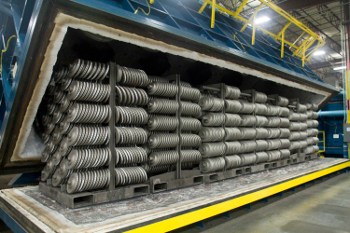 |
| February 07, 2012 | Volume 08 Issue 05 |
Designfax weekly eMagazine
Archives
Partners
Manufacturing Center
Product Spotlight
Modern Applications News
Metalworking Ideas For
Today's Job Shops
Tooling and Production
Strategies for large
metalworking plants
Wheels:
GM cooks up recipe for anti-rusting brake rotors

Brake rotors coming out of the oven in Flint, MI. [Photo by Jeffrey Sauger for General Motors]
A General Motors team of global brake experts is helping to make rusty brake rotors history by changing the chemical makeup of the components using a process that could double the life of rotors and save consumers hundreds of dollars.
The engineers developed an exclusive corrosion-protection process that super-heats the rotors at 560°C for a day in an oven the size of a tour bus. Inside the nitrogen-rich atmosphere, nitrogen atoms bond to the surface of the steel rotor, hardening and strengthening the rotor.
The name for the technology is Ferritic Nitro-Carburizing, or FNC, and it has most often been used to treat powertrain parts.
GM says that since its introduction on brake rotors in 2008, FNC has helped reduce warranty claims on brakes by 70%. This is significant because, in a recent consumer study conducted by GM, four in 10 vehicle owners listed corrosion among the top three bothersome things about their cars. The same study showed brake components at the top of the list of customer concerns.
More than 80% of U.S. vehicles are exposed to one or more environmental corrosion creators, such as acid rain, intense sunlight, snow and ice, and road salt. GM brake-rotor technical expert Jim Webster and his team were confident that slowing the oxidation brought on by the environment was a problem material science could solve.
Incorporating a unique surface treatment equivalent to one-tenth the width of a human hair, FNC creates sufficient friction and allows for effective braking performance while providing corrosion protection.
With FNC, GM vehicles are free of brake pedal or steering wheel shudder caused by an uneven buildup of rust on the rotor that occurs over time. FNC rotors create less brake dust than non-FNC rotors. And for vehicles with large open-architecture wheels that show off wheel hardware, FNC helps keep rotors looking clean and rust-free longer.
FNC rotor technology is featured on the Buick Lacrosse and Regal as well as on the Chevrolet Malibu, Impala, and Volt in North America. It will be featured on more than 80% of GM's U.S. vehicles by model year 2016.
By avoiding rotor repair and replacement, GM estimates that FNC treatment could save customers more than $400 over 10 years.
"Rotors aren't a cheap thing to replace," says Webster. "So doubling the average life expectancy of the brake rotors from 40,000 to 80,000 miles is something we think our customers will appreciate."
GM is the only company that has found a way to effectively treat brake rotors with the FNC process and has several patents pending on the technology.
Source: GM
Published February 2011
Rate this article
View our terms of use and privacy policy
